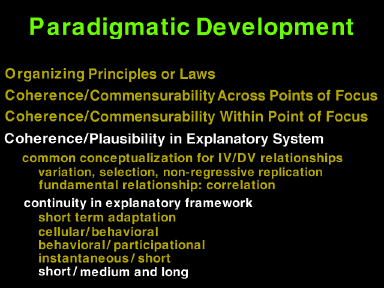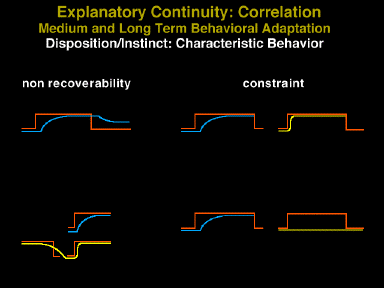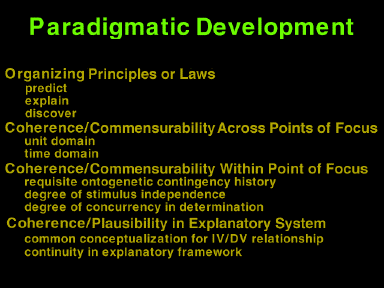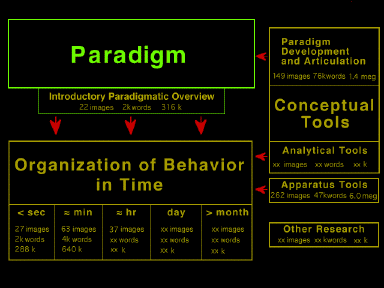 Slide 5-50
Slide 5-50

 Slide 5-50
Slide 5-50
Now for the continuity between short-term adaptation and the longer time scales.
 Slide 5-51
Slide 5-51
This is to show that medium- and long-term adaptation are the eventual result of an enduring exposure to short-term contingencies (i.e., they are simply aggregations across longer temporal windows) and that medium-term and long-term adaptation have as their precursors, short-term adaptation.
 Slide 5-52
Slide 5-52
The critical defining relationship of medium and long term adapatation is the failure of the relationship to adapt across other time spans. When seen from a short term perspective, developmental effects are nonrecovery of baseline. For example, the upper left portion of the slide shows a case where the 'A' behavior is not recovered in an ABA design (e.g. failure to reacquire the operant rate.) The lower left portion of the slide illustrates a case where reacquisition of a 'B' relationship is not the same as the original acquisition (e.g. relearning after extinction.)
The right two illustrations show that two species (blue vs yellow) may not show the same behavior to the same environmental conditions across the short term. The upper case shows a yellow species which adapts more quickly (upper) or does not adapt at all (lower) across the short term.
 Slide 5-53
Slide 5-53
Continuity between short term and both medium and long term adaptation is plausible if three relatively plausible assumptions are made:
1. If the speed with which a particular adaptation is learned varies.
2. If that adaptation is mediated by some reductionistic structural change, such as pre- or post-synaptic membrane modification.
3. If speed of learning (or adaptation) in some way indexes the structural bias of the associated neural elements to react that way (adaptation).
Then continuously selecting for faster speed of learning would also continuously select for greater neural structural predisposition to react that way, which would eventuate in the genetic control of that behavior. The implication of this is that the equilibrium point between ontogenetic learning only with great difficulty, to phylogenetic expression of the behavior is determined by enduring long term contingencies in the environment in exactly the same way as any structural element is equilibrated.
 Slide 5-54
Slide 5-54
Given any population, the speed of adaptation to a treatment will vary. This variation could be seen as synapses more or less prepared or predisposed "to learn.." If, for instance, speed of learning is continuously selected, then less and less or more and more ontogenetic experience will be necessary before the behavior will occur, given those contingencies.
Adaptation speed, or time it takes to acquire the behavior to each type of treatment will, over evolutionary time, work its way to the selected-for optimum.
It's clear that, as a result, each type of behavioral adaptation will be affectable across its optimal time scale. Those which are best when implemented without requiring "learning," such as pupillary contraction, will be implemented as a reflex; those which are best when implemented in such a way as to require sampling across a very long time, such as a particular language, will be implemented as a learned behavior.
This process yanks out the trait like a magnet would yank out iron from identical appearing sawdust, It is important to note that this is not inheritance of acquired characteristics. In the Lamarkian sense.
 Slide 5-55
Slide 5-55
End of paradigmatic context
 Slide 5-56
Slide 5-56
***** A CATALYST FOR DISCUSSION ON OBSERVABLES, INFERENCE, AND BEHAVIORISM. (670 words)
***** RESEARCH METHODS LECTURE NOTES Edition 2.2 (150k words)
***** THE CONCEPTUAL FOUNDATIONS OF BEHAVIOR ANALYSIS Edition 1.01 (PDF Format)
***** CONDITIONING AND LEARNING TEXT